
Wrecking Crew is an action game developed and published by Nintendo. Designed by Yoshio Sakamoto, it was first released as an arcade video game for the Nintendo VS. System in 1984, titled Vs. Wrecking Crew with a simultaneous two-player mode. It was released as a single-player game for the Family Computer (Famicom) console in 1985, and as a launch game for the Nintendo Entertainment System (NES) later that year. A sequel, Wrecking Crew '98, was released in Japan in 1998 for the Super Famicom.

Final Lap is a 1987 racing simulation video game developed and published by Namco. Atari Games published the game in the United States in 1988. It was the first game to run on Namco's then-new System 2 hardware and is a direct successor to Namco's Pole Position (1982) and Pole Position II (1983). It was ported to the Famicom by Arc System Works, making it Arc System Works' debut game.
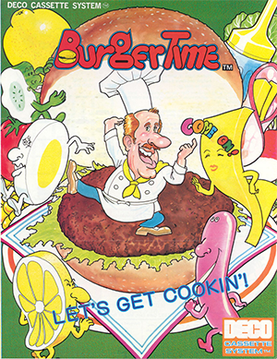
BurgerTime, originally released as Hamburger in Japan, is an arcade video game from Data East. It was published in 1982 for the DECO Cassette System. The player controls chef Peter Pepper who walks across oversized ingredients in a maze of platforms and ladders, causing them to fall and stack on buns below, eventually creating complete burgers. The chef is pursued by anthropomorphic hot dogs, fried eggs, and pickles. A limited supply of pepper can be thrown at aggressors immediately in front of Peter, briefly stunning them.
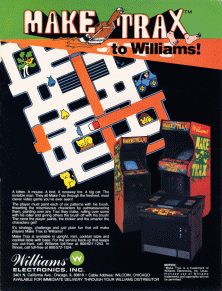
Make Trax, originally released in Japan as Crush Roller, is a 1981 maze game developed by Alpha Denshi and published as an arcade video game by Kural Samno Electric in Japan. It was licensed in Europe to Exidy, which released it under its original title Crush Roller, and in North America to Williams Electronics, who released it as Make Trax.

Elevator Action is a platform shooter game released in arcades by Taito in 1983. The player assumes the role of Agent 17, a spy infiltrating a 30-story building filled with elevators and enemy agents who emerge from closed doors. The goal is to collect secret documents from specially marked rooms, then escape the building. It runs on the Taito SJ System arcade system.

The Nintendo VS. System is an arcade system that was developed and produced by Nintendo. It is based on most of the same hardware as the Family Computer (Famicom), later released as the Nintendo Entertainment System (NES). As Nintendo was planning to release the NES in North America, they were aware of the video game crash of 1983 and its effects on the home console market. By March 1984 the arcade industry recovered enough for a plan to introduce NES titles there, with the VS. System later being a presentation to players who did not yet own the console. It became the first version of the Famicom hardware to debut in North America.
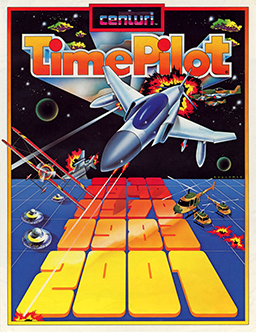
Time Pilot is a multidirectional shooter arcade video game designed by Yoshiki Okamoto and released by Konami in 1982. It was distributed in the United States by Centuri, and by Atari Ireland in Europe and the Middle East. While engaging in aerial combat, the player-controlled jet flies across open airspace that scrolls indefinitely in all directions. Each level is themed to a different time period. Home ports for the Atari 2600, MSX, and ColecoVision were released in 1983.

Wild Gunman is a light gun shooter game developed and published by Nintendo. Originally created as an electro-mechanical arcade game in 1974 by Gunpei Yokoi, it was adapted to a video game format for the Famicom console in 1984. It was released in 1985 as a launch game for the Nintendo Entertainment System (NES) with the Zapper light gun.

Keith Courage in Alpha Zones is a 1989 science fantasy platform game released by NEC for the TurboGrafx-16. It was the pack-in game for the console in North America. It was originally released in Japan by Hudson Soft on August 30, 1988 for the PC Engine, under the title Mashin Hero Wataru which is adapted from the anime television series of the same name. Hudson later released in 1990 another game for the Famicom based on the franchise titled Mashin Eiyuuden Wataru Gaiden Famicom, which is a role-playing video game.

Final Lap Twin is a hybrid racing/role-playing game developed by Nova and published by Namco. Released for the Japanese PC Engine in 1989 and the North American TurboGrafx-16 in 1990, it is a spin-off to the 1987 arcade game Final Lap.
Sun Corporation, is a Japanese electronics manufacturer, video game developer and publisher. They are known for their video games under the brand name Sunsoft.

Lock 'n' Chase (ロック・ン・チェイス) is a maze chase video game developed by Data East and released in arcades in Japan in 1981. It was licensed to Taito for distribution in North America. It has similarities to Pac-Man, including a goal of collecting dots, with the addition of doors that periodically block pathways. Home versions for the Intellivision and Atari 2600 were published by Mattel in 1982, and an Apple II version was released in January 1983.

Arabian is a 1983 arcade platform game developed and published by Sun Electronics (Sunsoft) in Japan, and Atari, Inc. in North America. A Famicom version was developed and released by Sunsoft only in Japan as Super Arabian. A distinct port for home computers developed by Interceptor Software was released as Tales of the Arabian Nights.
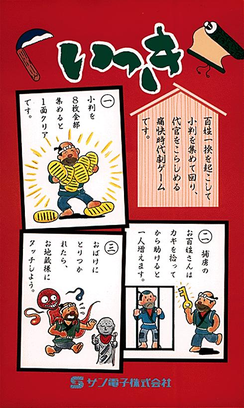
Ikki, known outside Japan as Boomerang and Farmers Rebellion, is a 1985 arcade game made by Sunsoft, and later ported to Family Computer. It is a multi-directional scrolling action game which contains some elements of a top-down shooter.

Cyber Sled is a vehicular combat video game developed and published by Namco. It was originally released for arcades in 1993. The game's perspective is third-person by default, but can be switched to a first-person perspective. The game was nominated for Most Innovative New Technology at the 1994 AMOA Awards. It later received a sequel in 1994, Cyber Commando.
Fitter, known as Round-Up in the Americas, is a maze-strategy arcade video game released by Taito in 1981. The game was released as Fitter, in Japan in October 1981 and in Europe the same year. Another Japanese company, Hiraoka, licensed a version called Round-Up to Centuri for release in the Americas in December 1981.

The Wing of Madoola is a 1986 action-platform video game developed and published by Sunsoft for the Family Computer. It stars Lucia, a magic-wielding warrior of the Rameru clan. Darutos, a descendant of the Rameru line, found the Wing of Madoola statue and used it to build a demonic fortress and summon demons to conquer the world. Lucia must retrieve the statue and stop Darutos. Throughout the journey, the player explores and search for items and power-ups to increase Lucia's attributes, while fighting enemies and defeating bosses.

Turbo is a racing game released in arcades in 1981 by Sega. Designed and coded by Steve Hanawa, the game received positive reviews upon release, with praise for its challenging and realistic gameplay, 2.5D color graphics with changing scenery, and cockpit sit-down arcade cabinet. It topped the monthly Play Meter arcade charts in North America and ranking highly on the Game Machine arcade charts in Japan.
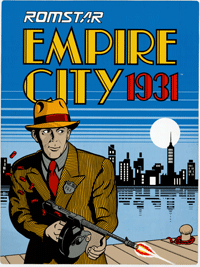
Empire City: 1931 is a shooter game developed by Seibu Kaihatsu that was originally released into arcades in 1986, by Taito in Japan and Europe and by Romstar in North America. The game has players taking on the mafia in 1931 New York City by gunning down mobsters one by one.

An arcade game or coin-op game is a coin-operated entertainment machine typically installed in public businesses such as restaurants, bars and amusement arcades. Most arcade games are presented as primarily games of skill and include arcade video games, pinball machines, electro-mechanical games, redemption games or merchandisers.



















